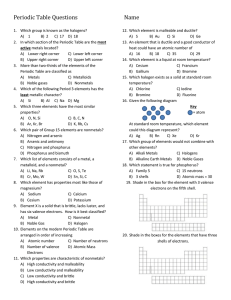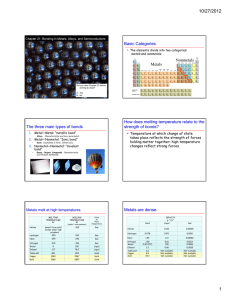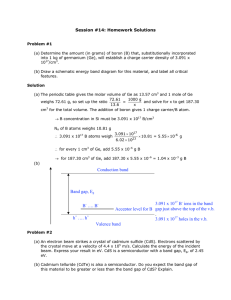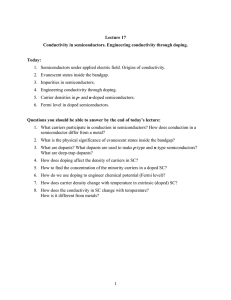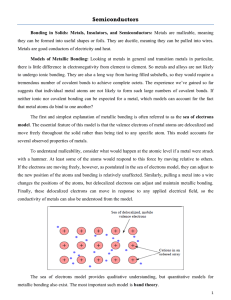Band theory pranjoto utomo
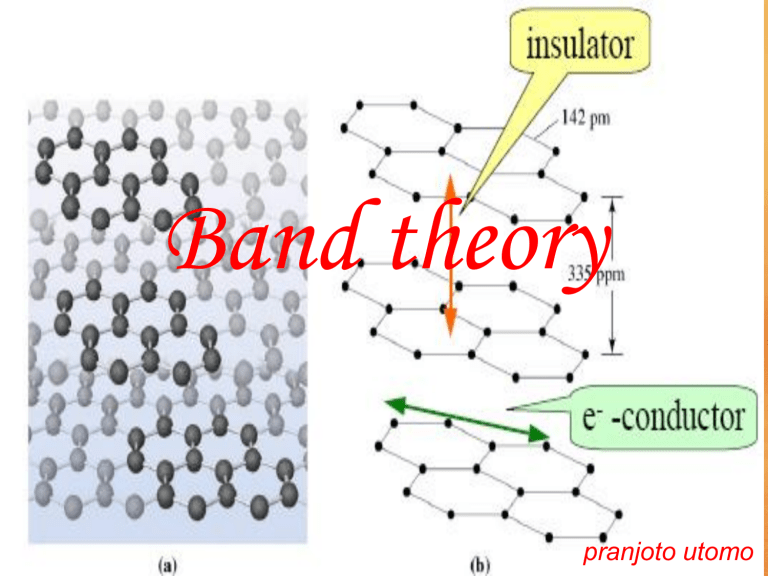
Band theory
pranjoto utomo
Metallic Bonds
• Band theory is an extension of molecular orbital theory that describes bonding in solids.
• Bands of orbitals that are filled or partially filled by valence electrons are called valence bands .
• Higher-energy unoccupied bands in which electrons are free to migrate are called conduction bands .
Bonding and Conductivity of Metals
• Metals:
– low electronegativity
– extensive delocalization of valence electrons
– high coordination numbers
– high electronic conductivity.
Bonding and Conductivity of Metals
• The conductivity of metal arises from:
– the delocalization of the electron energy levels over the entire solid.
– the availability of empty orbitals in a given band permitting movement of the electrons.
– Almost no energy is required to promote the electrons to the open level.
Bonding and Conductivity of Metals
• A metal can be viewed as an infinitely large molecule
• Using the concepts of Molecular Orbital theory and the LCAO approach the overlap of an infinite number of atomic orbitals leads to the formation of " Crystal
Orbitals "
Bonding and Conductivity of Metals
• From the MO treatment of diatomic, triatomic and multiatomic molecules we know that as the number of contributing
Atomic Orbitals is increased , the energy separation of the resultant Molecular
Orbitals is decreased .
Bonding and Conductivity of Metals
• As the half-filled 4s orbitals of an increasing number of Cu atoms overlap, their energies are split into a half-filled valence band.
Bonding and Conductivity of Metals
• Electrons can move from the filled half
(purple) to the slightly higher energy upper half
(red), where they are free to migrate from one empty orbital to another.
Band Gap
• The energy gap between the valence and conduction bands is called the band gap .
• A semiconductor is a substance whose conductivity can be made to vary over several orders of magnitude by altering its chemical composition.
Band Gap
The Fermi Energy (Level) is the energy of the highest occupied state.
Band gap
• The band gap influences:
– The electrical and optical properties of the material.
– Semiconductor “doping” can be used to create solar cell, diodes, transistors, etc.
Band Gap
Some semiconducting materials and associated bandgaps
(eV)
Semiconductor
• A n-type semiconductor contains excess electrons contributed by electron-rich dopant atoms.
• A p-type semiconductor contains electronpoor dopant atoms.
n –type semiconductor result from the addition of pentavalent impurities like phosphorus, arsenic and antimony. These donors contribute
“extra” electrons.
p –type semiconductor result from the addition of trivalent impurities like boron, aluminum and gallium.
These additions create valence “holes” which act as additional levels

